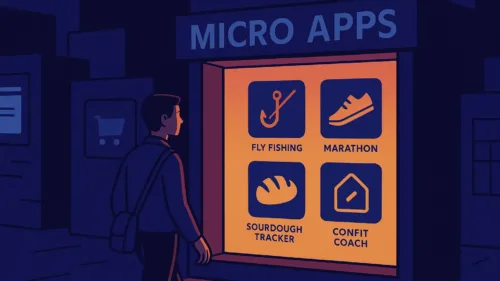We Need a Spotify for Micro Apps

So you built something.
Not a startup. Not a platform. Just a small, focused tool that solves a problem you had.
Maybe you used AI to scaffold it. Maybe it’s vibe-coded. Maybe it’s rough. But it works. It’s real. And maybe—just maybe—it could help someone else, too.
That’s when the question hits: Now what?
The Post-Creation Problem
Most people who build micro apps aren’t marketers. They’re not thinking about SEO or funnel strategy. They’re not paying for a product launch campaign.
They had a need. They built a thing. And now they’re sitting on something useful that no one knows about.
“Building the thing was the easy part. Figuring out what to do with it is where most creators get stuck.”
Worse: the places where software is supposed to get discovered—App Store, Product Hunt, Google Play—aren’t designed for this kind of work.
Those platforms reward scale. Design polish. Market readiness. They’re built for products trying to be the next big thing. Micro apps? They’re not trying to be big. They’re trying to be.
What We Need
We need a platform that treats micro apps like indie music.
Spotify didn’t just disrupt the music industry—it democratized it. It gave artists who couldn’t get signed to a label a way to reach an audience.
Why can’t software do the same?
“Micro apps aren’t startups. They’re creative tools—personal, purposeful, and often brilliant in their simplicity.”
Imagine a place where:
- Creators can publish their micro apps without jumping through VC-flavored hoops
- Users can browse niche tools based on need, interest, or community
- Discovery is built around specificity, not popularity
- Tools are validated for functionality, not funding
This isn’t a tech stack problem. It’s a distribution and permission problem. Right now, creators don’t know where to put their micro apps—and they’re unsure if they should.
A Micro App Store gives them both.
Where Southleft Comes In
Of course, not every vibe-coded app is ready for production. That’s where we help.
At Southleft, we’ve started quietly supporting indie creators—people who have ideas, build small tools, and need a hand getting them over the finish line.
We step in as a kind of mastering studio:
- Code review for security and performance
- Accessibility and compliance checks
- Light UI/UX refinement
- Optional hosting or hand-off support
Think of it as: vibe code to version one.
We don’t want to change the app. We just want to make sure it stands on solid ground. That it’s stable, shareable, and ready to be seen.
The Takeaway
The explosion of micro apps isn’t a phase. It’s a movement. But it’s missing infrastructure.
Spotify gave indie musicians a stage.
It’s time indie developers had one too.
And we want to help build it.
